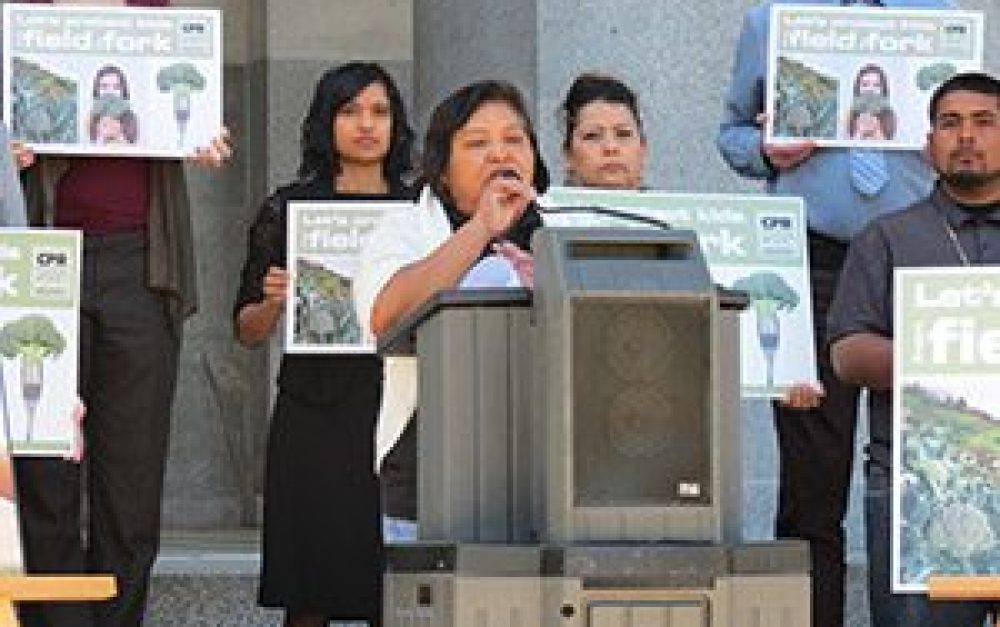Last Thursday, my daughter and I had the opportunity to join a group of Californians urging state officials in Sacramento to take action on the brain-harming pesticide chlorpyrifos. In an event organized by Californians for Pesticide Reform, we made our case to the cameras on the north steps of the capitol, then submitted a petition signed by over 12,000 people to the Department of Pesticide Regulation (DPR).
Members of the group El Quinto Sol de América from Tulare County were among those who traveled to Sacramento to help shake the agency into action. For these residents of the small Central Valley agricultural town of Lindsay, the problem of chlorpyrifos is personal.
Back in 2004, Lindsay residents began a three-year project testing the air surrounding their homes and schools for the presence of chlorpyrifos.
Using PAN's simple Drift Catcher tool, they collected over 300 air samples and found the chemical in more than three-quarters of these samples. In the third year, they found that over a quarter of air samples contained chlorpyrifos above levels EPA deems safe for infants and pregnant women.
Levels “of concern”
Twelve Lindsay residents also tested for chlorpyrifos levels in their bodies, and all but one had levels higher than those deemed to be “of concern” by the federal EPA.
DPR officials have known about these results since 2006, and the agency’s lack of adequate action has frustrated the residents of Lindsay — who continue to be exposed to this harmful chemical throughout California's long growing season. El Quinto Sol's director and Lindsay resident, Irma Medellin, expressed this frustration well at Thursday's press event:
“Our air and bodies are polluted with this neurotoxic pesticide. Our health and the health of our children are at risk, and California officials can't delay action any longer.”
The scientific evidence just keeps getting stronger that chlorpyrifos causes IQ deficits and delayed brain development in children, making the need for strong action increasingly urgent.
Natural Resources Defense Council's staff scientist Veena Singla underlined this urgency with her presentation at the press event:
“Policymakers have enough evidence to act. Research from across the globe shows that chlorpyrifos is a powerful neurotoxic chemical, especially for children. Even low levels can cause significant harm if exposure occurs during vulnerable windows of fetal and childhood brain development.”
Ongoing use — & exposure
Banned nationally in 2001 for home uses due to its harmful impacts on children, this organophosphate insecticide continues to be used in agricultural fields across the country.
Counties with the highest levels use over 200,000 lbs of chlorpyrifos per year.
In California in 2011, 1.6 million pounds of chlorpyrifos were reported sold. The counties with the highest use levels were Kern, Fresno and Tulare, with over 200,000 lbs of active ingredient used in each county that year. Chlorpyrifos was used predominantly on almonds in Kern, Fresno, and Stanislaus counties. Oranges and cotton received the highest chlorpyrifos applications in Tulare and Kings counties, respectively.
Chlorpyrifos is also found as a residue in many fruits and vegetables — meaning children are exposed throughout the state (and across the country), not just in agricultural areas. USDA data shows chlorpyrifos residues on apples, oranges, broccoli, grapes and more.
So while farmworkers and rural residents get exposed through chlorpyrifos drifting from field to their home, schools and playgrounds; urban residents are regularly exposed to the pesticide through residues on their food.
Long-term solutions
Chlorpyrifos is just one example of the damage a pesticide can do. Fortunately safer pest control solutions are available and already in use on farms across the country. In the long term, we need to create a food and farming system that doesn't rely on harmful pesticides like chlorpyrifos.
In our recent report A Generation in Jeopardy, we lay out some strategies that can help get us there:
- Pull agricultural pesticides off the market swiftly when independent science suggests harm to children.
- Block new pesticides from the market when studies show they may harm kids.
- Increase investment & support for innovative farmers who are stepping off the pesticide treadmill.
- Establish pesticide-free zones around schools, daycare centers, and neighborhoods in agricultural areas to protect children from harmful exposures.
I join thousands of others in urging DPR to take swift and strong action on chlorpyrifos so that communities across California can finally put concerns around this pesticide to rest. I'm hoping that day arrives soon.
Photo credit: CPR







